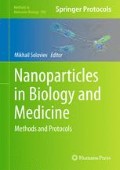Abstract
Ever since the discovery of carbon nanotubes, there has been an increasing interest in technologies that rely upon these incredibly small particles for their unique properties. However, assessment of their biological consequences has been riddled with assay limitations. Here, we describe application of a 3-(4,5-dimethylthiazol-2-yl)-5-(3-carboxymethoxyphenyl)-2-(4-sulfophenyl)-2H-tetrazolium cell viability assay to study cytotoxicity of various carbon-based nanomaterials on cells and discuss some pitfalls of this method.
Access this chapter
Tax calculation will be finalised at checkout
Purchases are for personal use only
References
Ijima S (1991) Helical microtubules of graphitic carbon. Nature 354:56–58
Dai L (ed) (2006) Carbon nanotechnology: recent developments in chemistry, physics, materials science and device applications. Elsevier, Amsterdam
Bottini M, Bruckner S, Nika K, Bottini N, Bellucci S, Magrini A, Bergamaschi A, Mustelin T (2006) Multi-walled carbon nanotubes induce T lymphocyte apoptosis. Toxicol Lett 160:121–126
Magrez A, Kasas S, Salicio V, Pasquier N, Seo JW, Celio M, Catsicas S, Schwaller B, Forro L (2006) Cellular toxicity of carbon-based nanomaterials. Nano Lett 6(6):1121–1125
Tian F, Cui D, Schwarz H, Estrada GG, Kobayashi H (2006) Cytotoxicity of single-wall carbon nanotubes on human fibroblasts. Toxicol In Vitro 20:1202–1212
Fiorito S, Serafino A, Andreola F, Bernier P (2006) Effects of fullerenes and single-wall carbon nanotubes on murine and human macrophages. Carbon 44:1100–1105
Sato K, Imai Y, Higashi N, Kumamoto Y, Mukaida N, Irimura T (2005) Redistributions of macrophages expressing the macrophage galactose-type C-type lectin (MGL) during antigen-induced chronic granulation tissue formation. Int Immunol 17:559–568
Jia G, Wang H, Yan L, Wang X, Pei R, Yan T, Zhao Y, Guo X (2005) Cytotoxicity of carbon nanomaterials: single-wall nanotube, multi-wall nanotube, and fullerene. Environ Sci Technol 39:1378–1383
Murr LE, Garza KM, Soto KF, Carrasco A, Powell TG, Ramirez DA, Guerrero PA, Lopez DA, Venzor J III (2005) Cytotoxicity assessment of some carbon nanotubes and related carbon nanoparticle aggregates and the implications for anthropogenic carbon nanotube aggregates in the environment. Int J Environ Res Public Health 2:31–42
Schrand AM, Citan SA, Shenderova OA (2009) Nanodiamond particles: properties and perspectives for bioapplications. Crit Rev Solid State Mater Sci 34:18–74
Schrand AM, Huang H, Carlson C, Schlager JJ, Ōsawa E, Hussain SM, Dai L (2007) Are diamond nanoparticles cytotoxic? J Phys Chem B 111:2–7
Schrand AM, Lin JB, Hens CS (2011) Temporal and mechanistic tracking of cellular uptake dynamics with novel surface fluorophore-bound nanodiamonds. Nanoscale 3:435–445
Schrand AM, Dai L, Schlager JJ, Hussain SM, Ōsawa E (2007) Differential biocompatibility of carbon nanotubes and nanodiamonds. Diamond Relat Mater 16:2118–2123
Acknowledgement
A.M.S. received funding from the National Research Council (NRC) and J.B.L. received funding from the S.T.E.P. program at AFRL/RHPB.
Author information
Authors and Affiliations
Corresponding author
Editor information
Editors and Affiliations
Rights and permissions
Copyright information
© 2012 Springer Science+Business Media, LLC
About this protocol
Cite this protocol
Schrand, A.M., Lin, J.B., Hussain, S.M. (2012). Assessment of Cytotoxicity of Carbon Nanoparticles Using 3-(4,5-Dimethylthiazol-2-yl)-5-(3-Carboxymethoxyphenyl)-2-(4-Sulfophenyl)-2H-Tetrazolium (MTS) Cell Viability Assay. In: Soloviev, M. (eds) Nanoparticles in Biology and Medicine. Methods in Molecular Biology, vol 906. Humana Press, Totowa, NJ. https://doi.org/10.1007/978-1-61779-953-2_32
Download citation
DOI: https://doi.org/10.1007/978-1-61779-953-2_32
Published:
Publisher Name: Humana Press, Totowa, NJ
Print ISBN: 978-1-61779-952-5
Online ISBN: 978-1-61779-953-2
eBook Packages: Springer Protocols

